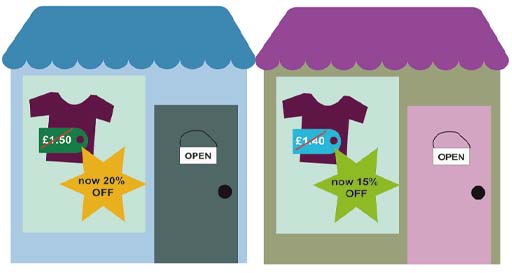1 Using percentages
Take a look at the two t-shirts in Figure 1 which are on sale. Which shop is offering the better deal? You’ll find out how to work this out and questions like it this week.
First, start by trying a refresher activity before moving onto some new ideas.
You will definitely find a calculator useful for Activity 1, which involves population figures.
Activity 1 Writing one number as a percentage of another
a.In 2020, the population of the European Union was about 447 700 000, and the total population of the Republic of Ireland was about 4 940 000. What was the population of the Republic of Ireland as a percentage of the total population of the European Union?
Hint: to find the percentage, you write the numbers as a fraction and multiply by 100.
Answer
First write the two numbers as a fraction:
Then multiply by 100, to give:
The answer is rounded to 1 decimal place. By necessity, population figures are estimates – so showing the answer any more accurately would not make sense in this case.
Rounded to 1 decimal place, the population of the Republic of Ireland was 1.1 per cent of the total population of the European Union in 2020.
- b.Now looking at one of the larger member states – Germany, which had a population of around 83 800 000 in 2020. Find the population of Germany as a percentage of the total population of the European Union, rounding your answer to 1 decimal place again.
Answer
Write the two numbers as a fraction gives:
Then multiply by 100, to give:
The population of Germany, rounded to 1 decimal place, was about 18.7 per cent of the total population of the European Union in 2020.
Hopefully, you felt confident from your practice last week in completing this refresher activity. If it proved slightly more challenging, you may find it useful to look back at Section 3 'What percentage is it?' in Week 5 [Tip: hold Ctrl and click a link to open it in a new tab. (Hide tip)] .
Another way that you will often see a percentage used is when saying what a certain percentage of a number is: for example, being advised when going on holiday that 10 per cent of the cost of a flight is a fuel surcharge, or that 15 per cent of a group of people have a preference for a certain food type. In the next section, you’ll look at how to use this information to find the actual numbers involved. Again, you should recognise some of these techniques from Week 5.

